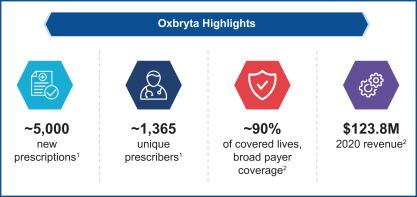in overall health status. In 2021, we have rolled out new educational materials to help patients and physicians understand the efficacy and safety profile of Oxbryta.
Expanding Access to Oxbryta
A top priority for GBT is to make Oxbryta available to more patients, including younger children with SCD. We believe that mitigating red blood cell sickling and destruction early in life will modify the course of the disease and alleviate future serious and life-threatening complications. In the U.S., we enrolled the first patients in our pediatric expanded access program, and we plan to submit a regulatory filing to potentially expand the Oxbryta label in the United States to include children ages 4 to 11 years.
We also initiated an early access program in Europe and other regions outside the United States, providing Oxbryta for eligible SCD patients as we work towards our goal of securing regulatory approvals around the world. To this end, we are pleased that the European Medicines Agency (EMA) is currently reviewing our Marketing Authorization Application (MAA) for potential approval of Oxbryta to treat hemolytic anemia in SCD patients ages 12 years and older. In the six Gulf Cooperation Council (GCC) countries in the Middle East, we are working with our distributor, Biopharma-MEA, to make Oxbryta available. We also intend to establish a similar distributorship for Latin America, including Brazil, where the bulk of the region’s SCD patients live. We are confident that Oxbryta will become a standard of care for treatment of SCD worldwide, and we believe we can expand access to more than 350,000 patients in the next several years.
Innovative Pipeline
In 2020, GBT advanced our exciting lead pipeline programs – inclacumab for vaso-occlusive crises (VOCs) and GBT021601 (GBT601) – both of which have the potential to be best-in-class SCD therapies.
Inclacumab is a P-selectin inhibitor that binds to a unique epitope on P-selectin that allows it to deliver more potency. We believe this will provide a competitive advantage by potentially enabling quarterly dosing compared to the currently available option, which has monthly intravenous dosing. We plan to initiate two global, randomized, placebo-controlled pivotal Phase 3 trials evaluating the safety and efficacy of inclacumab in the first half of 2021. One trial will focus on the reduction in VOCs and the second will focus on reducing 90-day hospital readmission following an initial VOC hospitalization. The two studies are carefully designed to potentially enable two independent regulatory submissions for separate indications.
GBT601 is a next-generation hemoglobin S polymerization inhibitor, the same mechanism as Oxbryta. Preclinical data shows that it has the potential to normalize hemoglobin through improved red blood cell survival and organ function. We believe this profile gives GBT601 the potential for greater efficacy by achieving higher hemoglobin occupancy at significantly lower doses. In December, we initiated a first-in-human Phase 1 study on the safety and tolerability of GBT601 in healthy volunteers. We plan to begin studying GBT601 in SCD patients in 2021, with a goal of providing proof-of-concept data by the end of the year.
In addition, GBT’s drug discovery teams are working on new targets to develop the next wave of treatments for SCD. We plan to expand our pipeline through our active business development efforts and our established collaborations, including our research collaboration with Syros Pharmaceuticals and our recent in-license of two early-stage programs from Sanofi.
In 2020, we continued to strengthen our leadership team with the appointment of Rajiv Patni, M.D., as chief medical officer, and the announcement that SCD thought leader and advocate Kim Smith-Whitley, M.D., will join GBT in May of this year as executive vice president and head of research and development. We also recently added Alexis Thompson, M.D., M.P.H., a world-renowned hematologist and former president of ASH, to our board of directors.
Values-driven Culture
| | |
| At GBT, we live our cultural values of accountability, inclusion, innovation and community, and, since our inception, we’ve worked to create a culture fostering workplace development, diversity, and inclusion (WDDI). In 2020, we continued to build a diverse team of talented professionals that enrich our culture and that will drive | | “We have made diversity a priority for our company, and it is woven into the cultural fabric of the company”. |
| our future growth and success. We have made diversity a priority for our company, and it is woven into the cultural fabric of the company. More than half of GBT’s employees |


